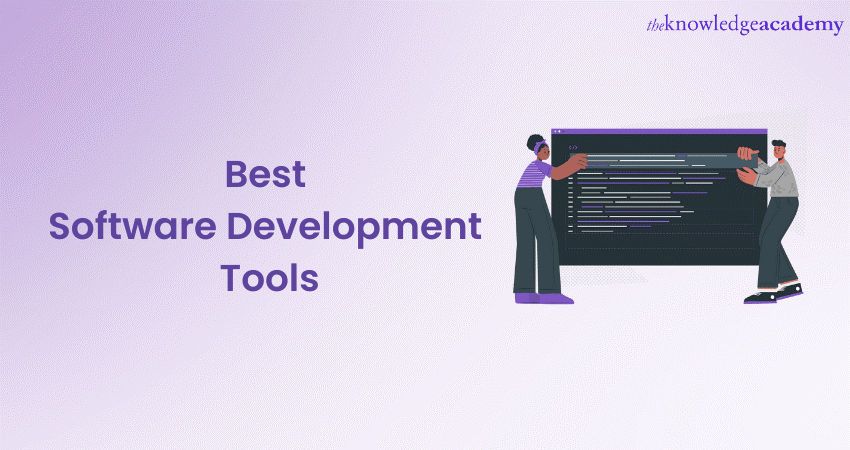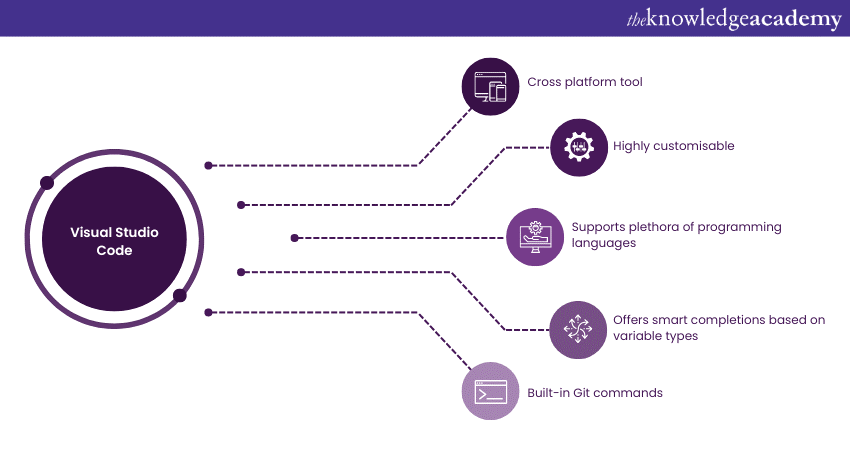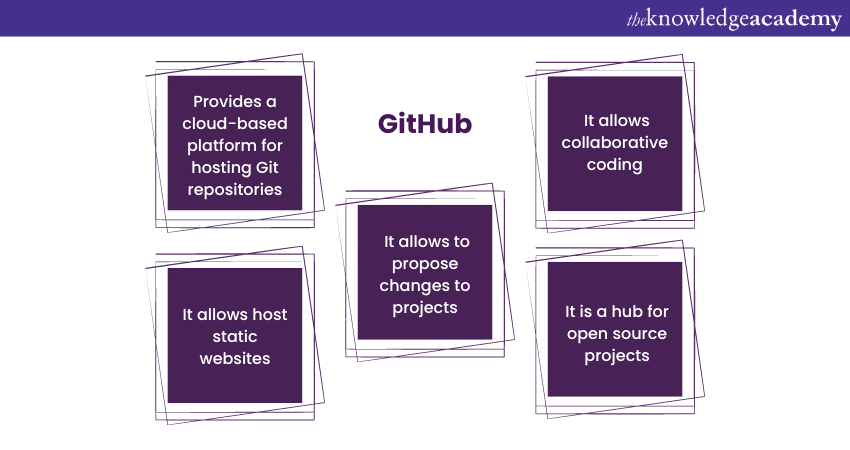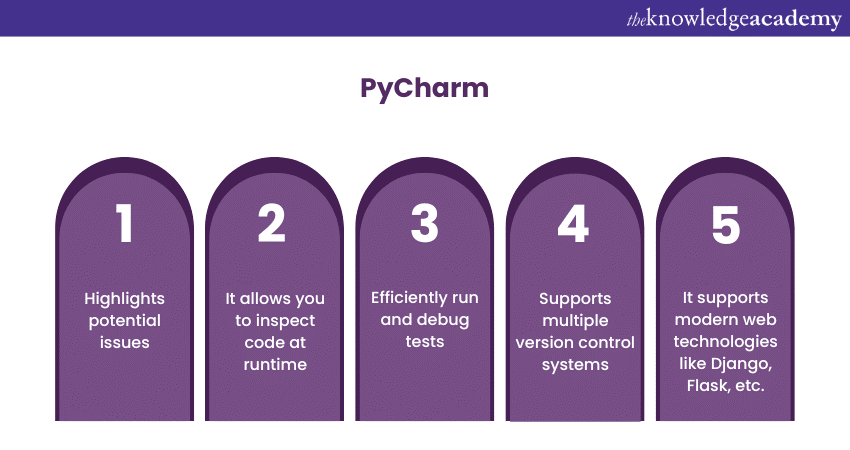We may not have the course you’re looking for. If you enquire or give us a call on 01344203999 and speak to our training experts, we may still be able to help with your training requirements.
Training Outcomes Within Your Budget!
We ensure quality, budget-alignment, and timely delivery by our expert instructors.

Are you a Software Developer or stepping for the first in Software Development? If yes, then you must be aware that there are some of the Best Software Development Tools available today to carry out your projects. Without the right tools for the right project, you might have a bad setback in achieving your targets.
According to Statista, the global developer population is expected to reach 28.7 million by 2024. This is a drastic increase from 3.2 million, as was seen in 2020. With such a huge increase in the number of developers, they might need the right kind of tools to cater for their development needs.
Thus, it’s time to learn about these solutions in detail. Read this blog to learn about 15 Best Software Development Tools Software Developers use to design, modify, support, and debug frameworks and applications.
Table of Contents
1) What are Software Development Tools?
2) Top 15+ Best Software Development Tools
a) Visual Studio Code
b) Eclipse
c) SQL Server Management Studio (SSMS)
d) Git
e) GitHub
f) Bitbucket
g) Trello
h) Travis CI
i) GitLab CI/CD
j) PyCharm
3) Conclusion
What are Software Development Tools?
Software Development tools, often termed as "dev tools," encompass a vast range of applications, frameworks, and platforms specifically designed to facilitate the various stages of software creation.
At their core, these tools assist developers in writing code, testing their functionality and debugging any issues. They also help ensure that the final product operates seamlessly for its end users.
However, you should know that these tools aren't just limited to writing and testing code. They also include tools for collaboration, version control, database management, UI/UX design, and even deployment. They act as the backbone of the IT industry. They not only streamline processes but also reduce errors, enhance productivity, and enable the creation of sophisticated and reliable software solutions for a dynamic technological world.
Unlock your potential in Software Engineering with our Software Development Lifecycle Training .
Top 15+ Best Software Development Tools
Let us now discuss some of the best Software Development Tools that developers can use to effortlessly develop efficient software as a Software Developer:
1. Visual Studio Code
Visual Studio Code (often abbreviated as VS Code) is a free, open-source code editor developed by Microsoft. It's cross-platform, available for Windows, macOS, and Linux. One of its standout features is the vast marketplace of extensions, allowing developers to add languages, debuggers, and tools to their environment. By default, it supports a plethora of programming languages, ensuring versatility for developers. Following are some of its key features:

a) VS Code features an integrated terminal that allows developers to run shell commands directly within the editor.
b) Built-in Git commands make version control seamless, facilitating easier tracking and management of code changes.
c) Advanced debugging features allow developers to run and debug code from within the editor, enhancing the coding and troubleshooting process.
d) It is highly customisable, which enables developers to tweak the interface, themes, settings, and key bindings to their preferences.
e) Being lightweight ensures that it boots up quickly, offering faster performance compared to some bulky IDEs.
f) It provides smart completions on the basis of variable types, function definitions, and imported modules, improving coding efficiency.
g) The "Live Share" feature enables real-time collaborative coding with team members, revolutionising team-based projects.
2. Eclipse
It is a renowned, open-source Integrated Development Environment (IDE) that stands out primarily for its flexibility and vast ecosystem. Initially developed by IBM and later supported by the Eclipse Foundation, it's predominantly known for Java application development. It is one of the best Software Development Tools. Here are its features:
a) While Java is its mainstay, Eclipse supports numerous programming languages like C, C++, PHP, and more, thanks to its extensive range of plugins.
b) Through its rich plugin system, developers can customise and extend its capabilities. This also helps them in tailoring the environment to specific project needs.
c) It can define distinct workspaces with multiple perspectives, ensuring an organised development experience, especially for large projects.
d) Eclipse provides robust performance optimisation features like code refactoring and memory analysers, which are essential for developing efficient applications.
e) Integrated tools like EGit offer seamless Git integration, simplifying version control for team-based projects.
f) Being open source means a vibrant community backs Eclipse. This active community continually contributes to its improvement. This ensures regular updates and provides ample learning resources for newcomers.
3. SQL Server Management Studio (SSMS)
It is an integrated environment developed by Microsoft to efficiently manage, administer, and develop all components of SQL Server. Launched alongside SQL Server 2005, SSMS has become an indispensable tool for database professionals working with Microsoft's SQL Server. Here's a closer look at its pivotal features and significance:
a) SSMS offers a comprehensive interface that combines both script editors and graphical tools. This helps developers to write SQL queries, manage databases, and monitor server performance, all from a single pane.
b) The query editor in SSMS offers syntax highlighting, IntelliSense (for code completion suggestions), and debugging capabilities that streamline SQL script development.
c) SSMS allows administrators to manage databases, tables, stored procedures, indices, and other SQL Server objects effortlessly through its Object Explorer.
d) With built-in tools like Activity Monitor and Performance Dashboard, SSMS provides insights into server performance. Thus, it helps administrators identify bottlenecks and optimise database operations.
e) It also ensures database security which is a cinch with SSMS. Administrators can manage server and database roles, user logins, and permissions through the interface.
f) Essential tasks like database backup and restoration can be performed easily using SSMS, ensuring data integrity and availability.
Enhance your knowledge of Software Engineering with our Software Engineering Training .
4. Git
Git is a revolutionary distributed version control system that has become the de facto standard for managing and tracking changes in source code. Created by Linus Torvalds in 2005. Widely adopted in the software industry, Git's prominence has given rise to platforms like GitHub, GitLab, and Bitbucket, fostering collaborative development. It is one of the Software Development Tools that has a lot of influence in the world of Software Development. Let us see how:
a) Unlike centralised version control systems, every Git clone is a full-fledged repository, ensuring that developers can have a complete codebase and history.
b) Git's powerful branching model enables developers to create isolated environments for features or bug fixes. Merging these branches once changes are finalised is seamless and efficient.
c) Operations in Git are performed locally, making it incredibly fast. This local focus significantly boosts performance as network latency is not a concern for most tasks.
d) Git uses a cryptographic method to keep track of changes, ensuring the integrity and consistency of project data.
e) Its staging area allows developers to format and review commits, ensuring that only intentional changes are included.
5. GitHub
GitHub is the world's leading platform for hosting and reviewing code, managing projects, and collaborating on software. Launched in 2008, it quickly became synonymous with Git repository hosting and open-source collaboration. Being the hub for open-source projects, GitHub has fostered a vast community of developers. It's not just a platform for code but also a networking venue for tech enthusiasts and professionals. Let's have a look at some more of its features:

a) GitHub provides a cloud-based platform for hosting Git repositories, making it effortless for developers to store, manage, and track changes in their codebase.
b) GitHub revolutionised collaborative coding. Developers can contribute to projects, review code, suggest changes, and merge modifications.
c) The pull requests feature allows developers to propose changes to a project. These proposed changes can be reviewed, discussed, and then seamlessly integrated.
d) Developers can host static websites directly from their repositories, making it easier to showcase projects, portfolios, or documentation.
e) GitHub boasts a rich ecosystem of integrations and apps. From continuous integration tools like Travis CI to project management add-ons like ZenHub, it enhances and optimises the development workflow.
6. Bitbucket
Bitbucket, owned by Atlassian, is a robust web-based platform designed for version control and collaboration. It allows teams to plan, collaborate on, test, and deploy code. Initially launched as an independent startup in 2008, Bitbucket was later acquired by Atlassian in 2010. Here are some of its key features:
a) Bitbucket supports both Git and Mercurial repositories, offering flexibility for teams with varied preferences.
b) It seamlessly integrates with Jira Software, a popular issue and project tracking tool. This integration streamlines task management, issue tracking, and code deployment.
c) Bitbucket facilitates code collaboration through its pull request feature. Developers can review, discuss, and approve code changes, ensuring quality and consistency.
d) With Bitbucket Pipelines, teams can automate builds, tests, and deployments within the platform, optimising the software delivery process.
e) Its branch permissions feature lets administrators control who can modify specific parts of a repository, reinforcing code security.
f) Bitbucket's rich marketplace offers a range of apps and integrations, allowing teams to customise their development workflow.
7. Trello
Trello is one of the widely acclaimed visual Software Development Tools that simplifies task and project management using cards and boards. Originating from a side project at the software firm Fog Creek Software and later spun off as a separate entity, Trello, with its intuitive design, became a go-to tool for both individual task management and collaborative team projects. Here are its some key features:
a) At Trello's core is the concept of boards, which contain lists (representing tasks or stages), and these lists house cards (individual tasks). This structure provides a bird's-eye view of a project's progress.
b) The platform's user-friendly design allows developers to easily move cards between lists, representing task progression or changing priorities.
c) Whether it's Software Development, content creation, or event planning, Trello's flexibility ensures it's adaptable to various workflows.
d) Known as 'Power-Ups', it can integrate with a myriad of tools like Slack, Google Drive, and Dropbox, amplifying its functionality.
e) Members can be added to cards, assign tasks, set due dates, and comment, fostering team communication and collaboration.
f) Cards can hold images, files, and links, adding depth and context to tasks.
8. Travis CI
Travis CI stands as a prominent Continuous Integration (CI) service that integrates with GitHub repositories to automate the Software Development workflow. Launched in 2011, Travis CI quickly gained traction in the open-source community for its ease of use and seamless GitHub integration. Here are some key attributes:
a) Once connected to a GitHub repository, Travis CI automatically runs tests on every commit and pull request, ensuring code reliability.
b) It supports numerous programming languages, including Python, Java, Ruby, and others, catering to a diverse range of projects.
c) Using the .travis.yml configuration file, developers can customise the build environment, specify dependencies, and define the build process to suit project needs.
d) Travis CI supports matrix builds. This allows the testing of code under multiple configurations, ensuring compatibility and robustness.
e) With support for Docker, Travis CI lets developers test their applications within containerised environments. This ensures consistent behaviour across different deployment platforms.
f) It also offers a premium version for private repositories. This ensures adaptability for both individual and organisational projects.
9. GitLab CI/CD
GitLab CI/CD is an integrated feature of the GitLab platform. It is one of the holistic Software Development Tools that encompasses the entire Software Development Lifecycle. While GitLab started as a web-based Git repository manager, its built-in CI/CD capabilities have set it apart from other Software Development Tools. Here's a closer examination of its CI/CD features:
a) GitLab offers CI/CD natively, ensuring a seamless and integrated workflow from code commit to deployment.
b) GitLab CI/CD provides a graphical representation of the pipeline stages, making it easier for developers to understand and monitor the progress of builds, tests, and deployments.
c) With its "Auto DevOps" feature, GitLab can automatically configure and optimise CI/CD pipelines. Thus, it reduces the manual setup effort and ensures best practices.
d) It supports running multiple jobs simultaneously, significantly speeding up the pipeline, especially for extensive projects.
e) It boasts first-class support for Docker, including Docker runners. Thus, it enables containerised build and test environments which ensure consistency across various stages.
f) Through the .gitlab-ci.yml configuration file, developers can have granular control over how the build and deploy processes work, catering to specific project needs.
10. PyCharm
It is a dedicated Integrated Development Environment (IDE) specifically tailored for Python development, brought to life by JetBrains. Designed to offer a comprehensive environment, PyCharm has carved out a significant niche among Python developers.

a) PyCharm provides advanced coding insights. It suggests improvements and highlights potential issues. This significantly aids in writing clean and efficient Python code.
b) It allows developers to inspect code at runtime, evaluate expressions, and track variable values, facilitating a smoother bug-fixing process.
c) With PyCharm, developers can efficiently run and debug tests. It uses popular frameworks like pytest, unittest, and nose, ensuring the robustness of the application.
d) PyCharm supports multiple version control systems, including Git, SVN, and Mercurial, streamlining collaborative efforts.
e) An integrated database editor and SQL support make database management within the application straightforward and effective.
f) PyCharm also supports modern web technologies like Django, Flask, and web2py. It positions as a versatile tool for full-stack developers.
g) Through plugins and themes, developers can personalise the interface to align with their preferences and project needs.
Craft impeccable software designs and architectures with our Java Programming and Software Engineering Fundamentals Training .
11. MySQL Workbench
MySQL Workbench is an official Integrated Development Environment (IDE) for MySQL databases provided by Oracle Corporation. Over the years, it has become an essential tool for database architects, administrators, and developers working with MySQL. Its multifaceted design offers a suite of intuitive tools for various database tasks. Here are some of the key features:
a) MySQL Workbench provides a visual interface where developers can create, alter, and view database schemas graphically. This feature makes it easier to understand and modify structures.
b) Its powerful SQL editor, complete with code highlighting, snippet support, and auto-completion, assists developers in writing optimised queries and scripts.
c) Through its server administration tools, MySQL Workbench facilitates tasks like server configuration, user management, backup and recovery, performance monitoring, and more.
d) MySQL Workbench includes a migration wizard that simplifies the process of migrating data from other databases, such as Microsoft SQL Server, to MySQL.
e) Its built-in tools aid in visual performance tuning and allow developers to optimise and improve the performance of MySQL databases by pinpointing bottlenecks.
f) The plugins of MySQL Workbench enable users to extend its functionalities to suit specific needs.
12. Slack
Slack is a communication platform designed to enhance collaboration within teams. It helps in blending the boundaries of email, messaging, and project management tools. Launched in 2013 by Stewart Butterfield, Eric Costello, Cal Henderson, and Serguei Mourachov, Slack has transformed how teams communicate in the modern workplace. Some of its key features are as follows:
a) Slack introduced the concept of 'channels' - topic-specific chat rooms. Teams can have channels for different projects, departments, or even casual topics, ensuring organised and relevant conversations.
b) For more private discussions, Slack offers direct messages where two or more members can converse away from public channels.
c) It also offers a vast ecosystem of integrations, connecting with countless third-party apps like Google Drive, Trello, and GitHub. Thus, it centralises various workflows.
d) Developers can easily share files by dragging and dropping them into the chat. It facilitates smoother exchanges of documents, images, and other files.
e) The search feature of Slack allows developers to quickly find past messages, files, and shared content, making information retrieval efficient.
f) With a marketplace full of apps, bots, and integrations, Slack can be tailored to meet the unique needs of every team.
13. Jenkins
Jenkins is an open-source automation server, synonymous with Continuous Integration (CI) and Continuous Delivery (CD) in the Software Development world. Originally developed by Kohsuke Kawaguchi in 2004, Jenkins has played a pivotal role in automating various stages of the development pipeline. Here's a detailed look at its salient features:
a) Jenkins automates the repetitive tasks in the development cycle, such as code compilation and testing. This ensures that code changes are continuously integrated into the main codebase without hiccups.
b) With over a thousand plugins available in its ecosystem, Jenkins can be tailored to handle nearly any development or deployment task. These plugins make it adaptable to varied project needs.
c) Jenkins supports the distribution of build tasks across multiple machines, allowing for faster code builds, especially for large projects.
d) Jenkins seamlessly integrates with popular development, testing, and deployment tools, making it a central hub for the development pipeline.
e) Being a Java-based application, it can run on various platforms, including Windows, macOS, and Linux.
f) As an open-source tool, it boasts a vibrant community that continuously contributes to its improvement, develops plugins and provides support to its users.
14. Selenium
Selenium is a prominent automation framework specifically designed for web applications. Initiated by Jason Huggins in 2004, it has since emerged as the gold standard for web-based Automated Testing. Its ability to mimic user behaviour in browsers and its compatibility across numerous platforms are just a couple of its standout qualities. Its key features are as follows:
a) Selenium supports many browsers, including Chrome, Firefox, Safari, and Internet Explorer. This ensures web applications work consistently across all user platforms.
b) It supports various programming languages, including Java, C#, Python, Ruby, or JavaScript, and Selenium accommodates all.
c) It is not just a single tool but a software suite, with Selenium WebDriver and Selenium Grid being its most notable components.
d) Selenium can be seamlessly integrated with tools like TestNG and JUnit for test management, and Jenkins for continuous integration.
e) Its ability to support testing in dynamic web pages—where element locations change—sets it apart.
f) Being open-source, Selenium provides the flexibility of customisation and has garnered a massive community contributing to its continuous enhancements.

15. JUnit
JUnit is a widely used testing framework explicitly designed for Java. It is vital in Test-Driven Development (TDD) and continuous integration. Created by Erich Gamma and Kent Beck, JUnit has been instrumental in promoting the practice of Automated Testing in Java applications. Here's a closer look at its key features:
a) JUnit is built on the principle of simplicity. It helps developers to write tests with minimal boilerplate code, focusing solely on the testing logic.
b) Using annotations like @Test, @Before, and @After, JUnit allows developers to define test methods, setup, and teardown operations effortlessly.
c) It provides a comprehensive set of assertion methods. This helps developers to verify the correctness of their code by comparing expected outcomes with actual results.
d) With its custom test runners, it provides flexibility in how tests are executed. It also allows for parallel test execution, parameterised tests, and more.
e) JUnit's extensible architecture means it can be easily integrated with other tools and libraries, enhancing its functionalities.
f) JUnit tests are commonly integrated into CI pipelines, ensuring that code changes don't introduce regressions.
Conclusion
Choosing the Best Software Development Tools can help you achieve your desired targets and carry out your projects efficiently. These tools offer innovation, adaptability, and efficiency, which is crucial for this changing technological world. These tools can help you maintain the quality of work and improve web development significantly.
Enhance your Java and Software Engineering fundamentals with our Java Programming and Software Engineering Fundamentals Training.







 Top Rated Course
Top Rated Course



 If you wish to make any changes to your course, please
If you wish to make any changes to your course, please


